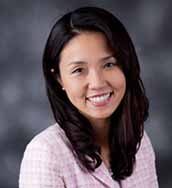Service learning transforms future teachers to advocates for English language learners, professor writes

LAWRENCE — The number of students who speak English as a second or an additional language is on the rise in the United States. Yet not all new teachers moving into their first classrooms have worked with diverse student populations. University of Kansas educators have found that when pre-service teachers get to know diverse students in and out of the classroom, they not only become better educators, they also become advocates for their students.
Education students typically join working teachers in their classrooms as part of a student teaching assignment. But in recent years, concerns have grown that the experience coupled with classes on a college campus isn’t sufficiently preparing teachers. Three KU educators have documented the experiences of pre-service teachers who engaged in service learning with English language learners and their teachers. They found the experience reduced concerns and anxiety about working with diverse populations, provided opportunity for self-reflection, and promoted feelings of self-efficacy, professional competency and a “demystification” of working with diverse learners.
 “Many of our education students haven’t had a lot of chances to work with diverse populations, and we want them to have the experience of working with English language learners before they become teachers,” said Hyesun Cho, associate professor of curriculum & teaching. “Because of the demographic change in this country, they will have English language learners in their future classroom and we, as teacher-educators, should prepare them for such a classroom.”
“Many of our education students haven’t had a lot of chances to work with diverse populations, and we want them to have the experience of working with English language learners before they become teachers,” said Hyesun Cho, associate professor of curriculum & teaching. “Because of the demographic change in this country, they will have English language learners in their future classroom and we, as teacher-educators, should prepare them for such a classroom.”
Cho described her findings in a chapter co-written with Peter Johnson and Sylvia Somiari, both doctoral students in the Department of Curriculum & Teaching, in the book “Facilitating Authentic Practices in Teacher Education Through Pedagogies of Enactment,” The book was edited by Chesla Ann Lenkaitis of Temple University and Shannon Hilliker of Binghamton University.
The preparation for working with linguistically diverse students is especially timely given the increase of such populations in American schools. And the growth is not confined to border states, as Kansas has shown with the nation’s largest percentage point increase in English language learner enrollment between 2002-2003 and 2012-2013. The authors describe the process of pre-service teachers engaged in service learning with diverse populations as part of their early field experience before student teaching. In addition to working with students and teachers in the classroom, the pre-service teachers were required to spend time with an “emergent bilingual” student outside of the classroom, interview them and their teacher and write about their experiences. They shared their findings with their classmates in the teaching methods course and wrote reflective journals throughout the semester. The researchers also conducted focus group interviews with the preservice teachers to learn about their experience in service learning and professional growth over time.
They were required to prepare lesson plans informed by the time they spent with their young learners and the teaching methods they learned from the course. The authors recount how the future teachers reported their mindsets about linguistically diverse students changed from the beginning of the semester.
“At first, a lot of them had a deficit mindset about English-language learners because of the stereotypes about them. Many pre-service teachers thought ELLs just need support from the teacher because they lack the English language. What they found was these students bring a lot to the table, including their linguistic and cultural knowledge. Many of them are high-achieving students as well, including gifted students. Some thought they all scored low on their tests and learned that is not the case.”
That breaking down of stereotypes was one of two major benefits the authors describe in their chapter. The second was learning to translate education theory into practice. The future teachers were better able to consider students’ perspectives and how theory can be applied in ways diverse students understand. Furthermore, the participants turned around deficit mindsets and became advocates for students, instead of simply someone at the front of their classrooms. That advocacy, which was frequently alluded to in the data, is superior to a “savior mindset” that is common before such experiences, Cho said.
The chapter also details student teachers’ experience working with practicing teachers. They learned about their day-to-day work, including challenges they face, such as finding enough time to do all that is required of them, lack of support from districts and lack of resources for their multilingual learners.
“This is the only TESOL (Teaching English to Speakers of Other Languages) methods course required for pre-service teachers to work with emergent bilingual students and their teachers in the teacher education program at KU,” Cho said. “They had authentic experiences and were able to work with students, paraeducators and teachers to learn what it takes to have positive outcomes for our diverse student populations in elementary schools.”
The book includes chapters on authentic practices that can boost experiences of teaching candidates through pedagogies of enactment, or acquiring lessons through experience in addition to learning in the classroom. Other chapters address practices such as boosting vocabulary through games and technology, professional learning communities, critical thinking, audio description, using classroom assessment data and many others.
Cho said she will continue to have her students take part in service learning and work with active teachers to continue to refine the service-learning program.
“This is a mutually beneficial experience for our teacher candidates and English-language learners and their teachers. By investigating young learners’ lived stories and working with them closely in and outside the classroom, our pre-service teachers became much more aware of the multifaceted nature of their identities as emergent bilinguals.”